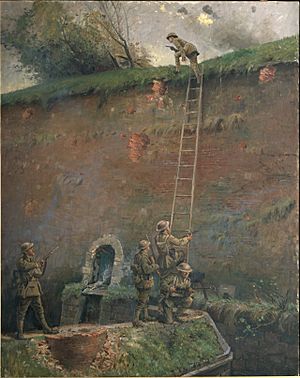Leslie Averill facts for kids
Quick facts for kids
Leslie Averill
|
|
|---|---|
| Birth name | Leslie Cecil Lloyd Averill |
| Born | 25 March 1897 |
| Died | 4 June 1981 (aged 84) |
| Allegiance | |
| Service/ |
|
| Rank | Second Lieutenant |
| Unit | 4th Battalion, New Zealand Rifle Brigade |
| Battles/wars | First World War |
| Awards | Order of St Michael and St George Military Cross |
| Relations | Alfred Averill (father) |
| Other work | Doctor Medical administrator |
Leslie Cecil Lloyd Averill (born March 25, 1897 – died June 4, 1981) was a brave soldier from New Zealand. He fought in the First World War on the Western Front. After the war, he became a doctor and helped lead medical services in his city, Christchurch.
Contents
Early Life and Education
Leslie Averill was born in Christchurch, New Zealand, on March 25, 1897. His father, Alfred Averill, was a local church leader who later became the Archbishop of New Zealand.
Leslie went to Christ's College and was a very good student. He was even the head student in 1915. The next year, he started studying medicine at Auckland University. But in 1916, his friend Paul Clark joined the army to fight in World War I. Leslie decided to join too.
Military Service in World War I
Leslie Averill became a second lieutenant after training. He arrived in France in May 1918 and joined the 4th Battalion of the New Zealand Rifle Brigade.
Battle of Bapaume
In August 1918, Leslie fought in the Second Battle of Bapaume. He showed great courage and leadership while leading his company. For his actions, he received the Military Cross award. After this battle, he worked in traffic control for the army.
Capturing Le Quesnoy
In November 1918, Leslie's unit was given a special mission. They had to capture the town of Le Quesnoy. This town was surrounded by strong walls, making it hard to attack. They also couldn't bomb the town because there were many civilians inside.
On November 4, 1918, Leslie, who was now an intelligence officer, looked for a way into the town. He found a path that the German soldiers weren't watching. His team brought a 30-foot ladder. Leslie bravely climbed the ladder to the top of the walls. He used his revolver to deal with two German guards. Soon, the rest of his team and then the whole battalion joined him inside the town. The German soldiers quickly gave up Le Quesnoy.
The war ended just one week later. Leslie stayed in Germany for several months as part of the occupation forces.
Life After the War
In October 1919, Leslie received a scholarship to study medicine. He went to the University of Edinburgh and became a medical doctor in 1924. He also became a Fellow of the Royal College of Surgeons of Edinburgh in 1925.
He returned to New Zealand in 1925 and married Isabella Mary Wilkie Roberton. She was also a doctor, but she did not work after they got married. They had five children together.
Medical Career and Leadership
In 1926, Leslie Averill started his own medical practice in Christchurch. He also became very involved in managing medical services. He helped open a private hospital in Papanui in 1928 and worked there for over 40 years. He was also the medical leader at St Helens Hospital from 1929 to 1962.
Leslie was a leader for many medical groups, including the North Canterbury Hospital Board. In 1961, he was honored for his important work in medicine. He was made a Companion of the Order of St Michael and St George.
His contributions weren't just in medicine. He also served on the board of governors for Christ's College for almost 20 years. He was also a president of the Old Boy's Association for his old high school.
Leslie retired from his medical practice in 1967. He continued to be involved with the ChristChurch Cathedral, where he had served since 1943. He passed away on June 4, 1981. He was survived by his wife and four children.
Legacy and Honors
Leslie Averill always kept a special connection with the town of Le Quesnoy. In 1923, he returned to the town to help unveil the New Zealand War Memorial.
In 1968, on the 50th anniversary of Le Quesnoy's liberation, the town made Leslie an honorary citizen. Five years later, in 1973, the French President honored him with the Chevalier of the Légion d'honneur award. During another visit, a new school and a street in Le Quesnoy were named after him.


